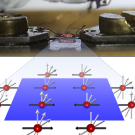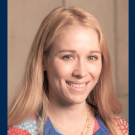
A research team has found the strongest evidence yet of a novel type of superconducting material, a fundamental science breakthrough that may open the door to coaxing superconductivity — the flow of electric current without a loss of energy — in a new way.
The discovery also lends tangible support to a long-held theory about superconductivity — that it could be based upon electronic nematicity, a phase of matter in which particles break their rotational symmetry.
Here is what that means. In iron selenide crystals mixed with sulfur, iron atoms are positioned in a grid. At room temperature, an electron in an iron atom cannot distinguish between horizontal and vertical directions. But at lower temperatures, the electron may enter a “nematic” phase, where it begins to prefer moving in one direction or the other.
In some instances, the electron may start to fluctuate between preferring one direction, then the other. This is called nematic fluctuation.
For decades, physicists have attempted to prove the existence of superconductivity due to nematic fluctuations, with little success. But the new study, a multi-institutional effort led by Yale University's Eduardo H. da Silva Neto, offers promise.
The findings, which appear in the journal Nature Physics, are the culmination of a research effort funded by the National Science Foundation as part of a Career Award grant to da Silva Neto’s lab, first at the University of California, Davis and now at Yale.
“We started on a hunch that there was something interesting happening in certain iron selenide materials mixed with sulfur, relating to the relationship between superconductivity and nematic fluctuations,” said da Silva Neto, who is assistant professor of physics in Yale’s Faculty of Arts and Sciences and a member of the Energy Sciences Institute at Yale’s West Campus.
“These materials are ideal because they display nematic order and superconductivity without some of the drawbacks, such as magnetism, that can make it difficult to study them,” da Silva Neto said. “You can detach magnetism from the equation.”
But it’s not easy. For the study, the researchers chilled iron-based materials down to a temperature of less than 500 millikelvins over a period of several days. To track the material, they used a scanning tunneling microscope (STM) — which takes images of the quantum states of the electrons at the atomic level.
Focusing their studies on the iron selenides with maximum nematic fluctuations, the researchers looked for a “superconducting gap” — a well-established proxy for the existence and strength of superconductivity. The STM images enabled the researchers to find a gap that was an exact match for superconductivity caused by electronic nematicity.
“This has been elusive to prove, because you have to do the challenging STM measurements at very low temperatures to be able to measure the gap accurately,” da Silva Neto said. “The next step is to look even more closely. If we keep increasing the sulfur content, what will happen with the superconductivity? Will it die? Will spin fluctuations return? Several questions come up that we will explore next.”
Co-lead authors of the study are Yale graduate students Pranab Kumar Nag and Kirsty Scott.
Additional co-authors from Yale include Xinze Yang and Aaron Greenberg, as well as Valentin Taufour, Peter Klavins and Journey Byland from the University of California, Davis; and researchers from the University of Minnesota; Universidade Federal de Goiás in Brazil; the University of Campinas in Brazil; and Fairfield University.
This article is adapted from a press release appearing on the Yale News website.
YOU MAY ALSO LIKE THESE STORIES

Researchers Improve Method to Investigate Origins of Superconductivity
In a study appearing in Review of Scientific Instruments, UC Davis researchers report a refined NMR method for investigating condensed matter materials, improving the sensitivity of the method by roughly 1,000 times.

UC Davis Physicist Receives $1.25 Million Grant to Investigate Superconductivity
Professor Inna Vishik joins 18 other researchers from across the nation who will each receive a five-year, $1.25 million grant to pursue new research goals and explore uncharted, innovative ideas.
